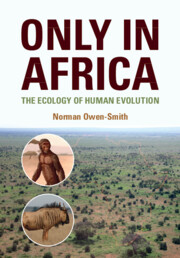Book contents
- Only in Africa
- Only in Africa
- Copyright page
- Dedication
- Contents
- Foreword
- Preface
- Abbreviations
- Part I The Physical Cradle: Land Forms, Geology, Climate, Hydrology and Soils
- Chapter 1 High Africa: Eroding Surfaces
- Chapter 2 Climate: Rainfall Seasonality
- Chapter 3 Water in Rivers, Lakes and Wetlands
- Chapter 4 Bedrock Geology: Volcanic Influences
- Chapter 5 Soils: Foundations of Fertility
- Part I Synthesis: Structure of the Physical Cradle
- Part II The Savanna Garden: Grassy Vegetation and Plant Dynamics
- Part III The Big Mammal Menagerie: Herbivores, Carnivores and Their Ecosystem Impacts
- Part IV Evolutionary Transitions: From Primate Ancestors to Modern Humans
- Appendix Scientific Names of Extant Animal and Plant Species Mentioned in the Book Chapters (Ecologically Conservative with Regard to Species Recognition)
- Index
Part I - Synthesis: Structure of the Physical Cradle
from Part I - The Physical Cradle: Land Forms, Geology, Climate, Hydrology and Soils
Published online by Cambridge University Press: 09 September 2021
- Only in Africa
- Only in Africa
- Copyright page
- Dedication
- Contents
- Foreword
- Preface
- Abbreviations
- Part I The Physical Cradle: Land Forms, Geology, Climate, Hydrology and Soils
- Chapter 1 High Africa: Eroding Surfaces
- Chapter 2 Climate: Rainfall Seasonality
- Chapter 3 Water in Rivers, Lakes and Wetlands
- Chapter 4 Bedrock Geology: Volcanic Influences
- Chapter 5 Soils: Foundations of Fertility
- Part I Synthesis: Structure of the Physical Cradle
- Part II The Savanna Garden: Grassy Vegetation and Plant Dynamics
- Part III The Big Mammal Menagerie: Herbivores, Carnivores and Their Ecosystem Impacts
- Part IV Evolutionary Transitions: From Primate Ancestors to Modern Humans
- Appendix Scientific Names of Extant Animal and Plant Species Mentioned in the Book Chapters (Ecologically Conservative with Regard to Species Recognition)
- Index
Summary
The preceding chapters have described the physical features distinguishing Africa from other continents. Africa is mostly high-lying in its eastern and southern interior with almost equal sections north and south of the equator. Its high interior elevation is due initially to its central location within Gondwana, amplified by tectonic uplift continuing from the Miocene into the Pleistocene. Eastern escarpments generated rain shadows, lowering precipitation leeward in tropical and subtropical latitudes and especially via season restrictions. Both rivers and lakes have fluctuated widely in flow regimes and water levels. All east-flowing rivers may be crossed without swimming in their upper reaches during dry seasons. Ramifying rift valleys disrupted surface topography through the east and generated the local depositional basins that have retained fossils. The major depositional basin in the west accumulated loose sands while in the east sediments extended coastlines. Africa’s eroding plateau surface exposed soils to bedrock influences, fostered additionally by reduced leaching due to the lowered rainfall. Volcanic activity associated with rifting contributed mafic geological substrates generating relatively fertile soils for the tropics. Southern Africa retains volcanic contributions from feeder pipes to the basalt eruptions that accompanied the breakup of Gondwana. Within regions underlain by basement granitic substrates, local hotspots of fertility are associated with wetlands, former lake beds and smaller-scale drainage basins.
- Type
- Chapter
- Information
- Only in AfricaThe Ecology of Human Evolution, pp. 61 - 62Publisher: Cambridge University PressPrint publication year: 2021

